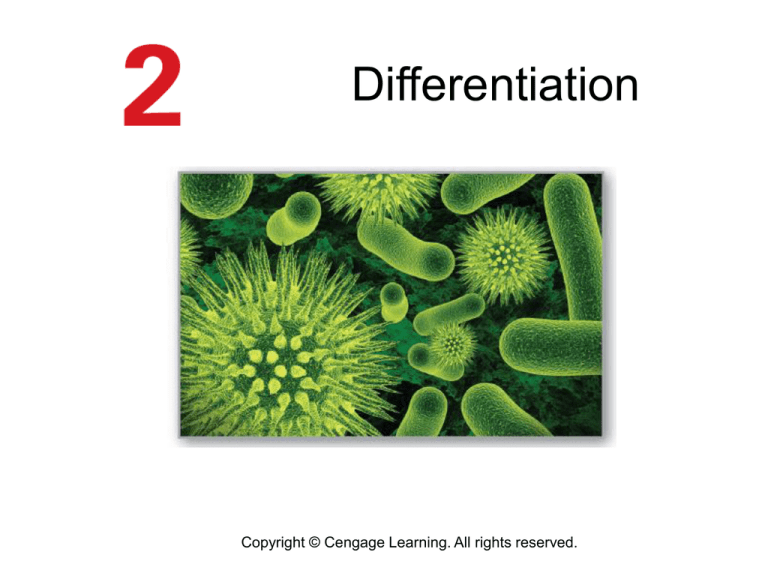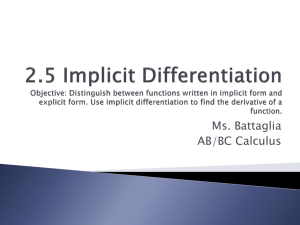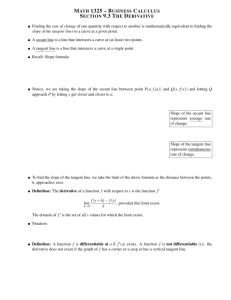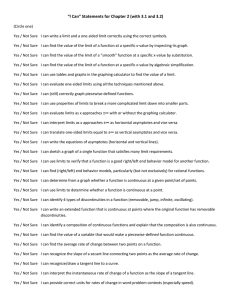
Differentiation
Copyright © Cengage Learning. All rights reserved.
The Derivative and the
Tangent Line Problem
Copyright © Cengage Learning. All rights reserved.
Objectives
Find the slope of the tangent line to a curve at a point.
Use the limit definition to find the derivative of a
function.
Understand the relationship between differentiability
and continuity.
3
The Tangent Line Problem
4
The Tangent Line Problem
Calculus grew out of four major problems that European
mathematicians were working on during the seventeenth
century.
1. The tangent line problem
2. The velocity and acceleration problem
3. The minimum and maximum problem
4. The area problem
Each problem involves the notion of a limit, and calculus
can be introduced with any of the four problems.
5
The Tangent Line Problem
What does it mean to say that a line is tangent to a curve at
a point? Essentially, the problem of finding the tangent line
at a point P boils down to the problem of finding the slope
of the tangent line at point P.
You can approximate this slope using a secant line
through the point of tangency and a second point on the
curve, as shown in Figure 2.3.
Figure 2.3
6
The Tangent Line Problem
If (c, f(c)) is the point of tangency and
is a second point on the graph of f, the slope of the secant
line through the two points is given by substitution into the
slope formula.
The right-hand side of this equation is a difference
quotient. The denominator x is the change in x, and the
numerator y = f(c + x) – f(c) is the change in y.
7
The Tangent Line Problem
You can obtain more and more accurate approximations of
the slope of the tangent line by choosing points closer and
closer to the point of tangency, as shown in Figure 2.4.
Figure 2.4
8
The Tangent Line Problem
The slope of the tangent line to the graph of f at the point
(c, f(c)) is also called the slope of the graph of f at x = c.
9
Example 1 – The Slope of the Graph of a Linear Function
To find the slope of the graph of f when c = 2, you can apply
the definition of the slope of a tangent line, as shown.
10
Example 1 – Solution
cont’d
The slope of f at (, f(c)) = (2, 1) is m = 2, as shown in Figure
2.5. Notice that the limit definition of the slope of f agrees
with the definition of the slope of a line.
Figure 2.5
11
The Tangent Line Problem
The definition of a tangent line to a curve does not cover
the possibility of a vertical tangent line.
For vertical tangent lines, you can use the following
definition.
If f is continuous at c and
the vertical line x = c passing through (c, f(c)) is a vertical
tangent line to the graph of f.
12
The Tangent Line Problem
For example, the function shown in Figure 2.7 has a
vertical tangent line at (c, f(c)).
Figure 2.7
13
The Tangent Line Problem
When the domain of f is the closed interval [a, b], you can
extend the definition of a vertical tangent line to include the
endpoints by considering continuity and limits from the right
(for x = a) and from the left (for x = b).
14
The Derivative of a Function
15
The Derivative of a Function
The limit used to define the slope of a tangent line is also
used to define one of the two fundamental operations of
calculus—differentiation.
16
The Derivative of a Function
Be sure you see that the derivative of a function of x is also a
function of x.
This “new” function gives the slope of the tangent line to the
graph of f at the point (x, f(x)), provided that the graph has a
tangent line at this point. The derivative can also be used to
determine the instantaneous rate of change (or simply rate of
change) of one variable with respect to another.
The process of finding the derivative of a function is called
differentiation. A function is differentiable at x if its derivative
exists at x and is differentiable on an open interval (a, b) if it is
differentiable at every point in the interval.
17
The Derivative of a Function
In addition to f ′(x), which is read as “f prime of x,” other
notations are used to denote the derivative of y = f(x).
The most common are
The notation dy/dx is read as “the derivative of y with
respect to x” or simply “dy, dx.” Using limit notation, you
can write
18
Example 3 – Finding the Derivative by the Limit Process
To find the derivative of f(x) = x3 + 2x, use the definition of
the derivative as shown.
19
Example 3 – Solution
cont’d
20
Differentiability and Continuity
21
Differentiability and Continuity
The alternative limit form of the derivative is useful in
investigating the relationship between differentiability and
continuity. The derivative of f at c is
provided this limit exists
(see Figure 2.10).
22
Figure 2.10
Differentiability and Continuity
Note that the existence of the limit in this alternative form
requires that the one-sided limits
exist and are equal.
These one-sided limits are called the derivatives from the
left and from the right, respectively.
It follows that f is differentiable on the closed interval
[a, b] if it is differentiable on (a, b) and if the derivative from
the right at a and the derivative from the left at b both exist.
23
Differentiability and Continuity
When a function is not continuous at x = c, it is also not
differentiable at x = c.
For instance, the greatest integer function
is not continuous at x = 0, and so it is not differentiable at
x = 0 (see Figure 2.11).
Figure 2.11
24
Differentiability and Continuity
You can verify this by observing that
and
Although it is true that differentiability implies continuity,
the converse is not true.
That is, it is possible for a function to be continuous at x = c
and not differentiable at x = c.
25
Example 6 – A Graph with a Sharp Turn
The function
continuous at x = 2.
shown in Figure 2.12, is
Figure 2.12
26
Example 6 – A Graph with a Sharp Turn
cont’d
However, the one-sided limits
and
are not equal.
So, f is not differentiable at x = 2 and the graph of f does
not have a tangent line at the point (2, 0).
27
Differentiability and Continuity
A function that is not differentiable at a point at which its
graph has a sharp turn or a vertical tangent line.
The relationship between continuity and differentiability is
summarized below.
1. If a function is differentiable at x = c, then it is continuous
at x = c. So, differentiability implies continuity.
2. It is possible for a function to be continuous at x = c and
not be differentiable at x = c. So, continuity does not
imply differentiability.
28









